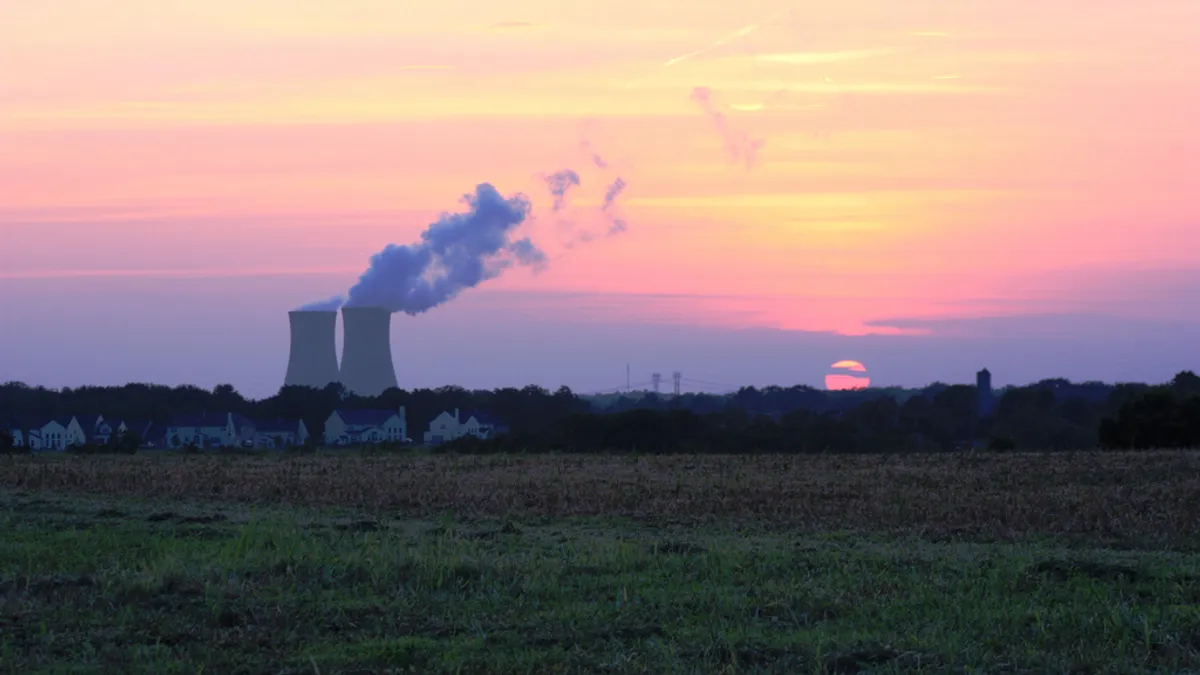Dive Brief:
- Small modular reactors (SMRs) have the potential to be a "game changer" for the U.S. nuclear energy sector after years of decline, officials from industry and the federal government told House lawmakers Tuesday.
- SMRs, expected to be commercially available in the mid-2020s, could start at $1 billion to $1.5 billion to construct, a Department of Energy official said, "potentially dramatically opening up the market" for utilities that cannot afford larger reactors.
- The Nuclear Energy Institute also reiterated calls for pricing reforms in wholesale power markets to save existing nuclear plants from retirement. The CEO of the trade group told reporters its members are satisfied with its lobbying practices, despite the high-profile departure of two major utility members.
Dive Insight
At the outset, Tuesday's hearing on U.S. nuclear energy at the House Energy and Commerce Committee looked set to be a glum affair. Last year's failure of the V.C. Summer nuclear project in South Carolina means there is currently only one nuclear project under construction in the United States, and federal officials say not many more are in the pipeline.
"We have a pipeline that once had around 27 [nuclear] units in 2007-2008 working its way through the Nuclear Regulatory Commission," said Edward McGinnis, principal deputy assistant secretary for nuclear energy at DOE. "[Today,] we have a grand total of one construction and operation license going thru with Florida Power and Light and one SMR design."
That SMR design, however, could be a "game changer" for the industry in terms of its cost compared with larger, traditional reactors.
"As opposed to an $8 billion unit for a gigawatt [or] larger before financing," he said, "you’re looking at a unit that may cost $1 billion to $1.5 billion put that base plant in, with $350 million to $450 million per unit to add to it, allowing a utility to take bites at a time."
That could break down significant barriers to nuclear generation at smaller utilities, and in countries with limited finances or smaller grids that do not need large-scale reactors.
"I think the implication is potentially dramatically opening up a market, a market that would never have materialized with large reactors," McGinnis said. "As valuable as large reactors still are, we simply have utilities that don't have the financial wherewithal and also are very excited about the design attributes."
Those design attributes include a system of 12 individual generating units, McGinnis said, each operating independently to allow the plant to follow load, much like a gas generator. While some large plants overseas take on modest load-following responsibilities, NRC regulations in the U.S. prevent traditional reactors from doing so.
The emerging SMR designs are so flexible, he added, that DOE is currently studying pairing them with wind and solar resources at Idaho National Laboratory.
"The intent is to offer the operator significant versatility in having different load following or power generation throughout the day," McGinnis said. "That is a powerful combination with intermittent [generation] and bringing in the emissions-free baseload generation. It's quite exciting in my view."
DOE currently has a development partnership with SMR designer NuScale, and the federal government has committed $200 million so far for development. The company won a key safety approval from the NRC last month and expects its first reactors to be operational in 2026.
DOE is also researching microreactors of up to 30 MW, McGinnis said, particularly one company "that has plans of potentially deploying its first micro reactor by 2021." But the DOE official did not name the firm and left before reporters could ask questions.
Optimism over SMRs at the hearing was mixed with the bitter reality of continuing nuclear retirements in the U.S. In September, the DOE proposed a cost recovery package that would have benefited nuclear and coal generators in wholesale power markets, but FERC unanimously rejected it last month.
NEI was a chief supporter of the plan and now is pushing for swift changes in power market pricing to keep existing nukes afloat. At the hearing, CEO Maria Korsnick said those changes may not come soon enough to save some at-risk plants.
"Ultimately we do favor a market solution but I would say that market solution is too slow in coming," she said. "We need a process where the market really values how the electrons were produced and not just that electrons are thrown on to the grid."
NEI's lobbying for the DOE rule and market changes have angered some in the nuclear sector. Last month, major nuclear operators NextEra and Entergy announced they would not renew their NEI membership, largely over the public policy push. NextEra is now suing NEI over access to a trade group database.
Despite those upheavals, Korsnick said after the hearing that the rest of NEI's membership remains satisfied, though she could not say if other companies would leave the organization.
"That's not something I can conjecture on," she said. "I would just say we have a lot of very happy members."














